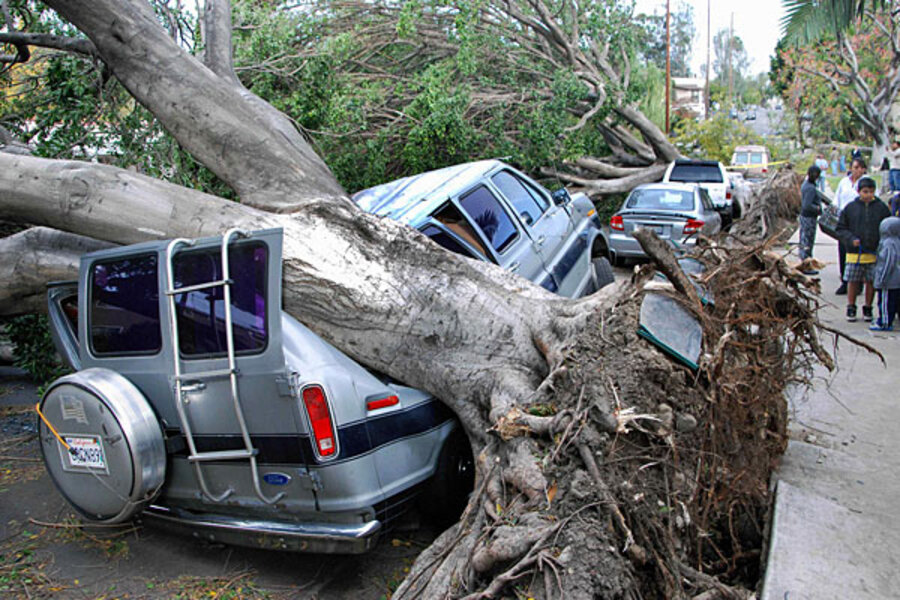Santa Ana winds: How the West was hit by hurricane-speed winds
Loading...
Hurricane-force winds whipped through much of the western United States Thursday, sparking wildfires, knocking out power and flipping semi-trucks — but there's no tropical storm driving the intense gusts.
In Southern California, these freakish winds are called Santa Ana winds, strong down-slope winds that blow through the Santa Ana Mountain passes at speeds of 40 mph (64 kph), according to the National Weather Service.
The current weather system caused damage far outside of sunny SoCal, however, and the winds are among the worst in decades, meteorologists said. Widespread gusts as strong as those of Hurricane Irene at landfall are expected to continue into Friday, Dec. 2. Firefighters in California are responding to wildfires spread by the winds and a major stretch of interstate was shut down Thursday because of toppled trucks.
The strong winds throughout the West Coast are caused by an extreme pressure change between the Northwest and Southwest regions. A sprawling high-pressure system following a cold front has created a difference in pressure that sends wind surging southward. In the Northwest, a strong high-pressure system built along with a clockwise flow of winds. In the Southwest, a low-pressure system developed along with a counter-clockwise flow. The tight so-called pressure gradient that formed between these systems is driving winds over mountains and through the California canyons.
The winds can be of tropical storm strength(winds less than 74 mph, or 119 kph) at lower elevations and hurricane-strength (74 mph or greater) above 1,000 feet (305 meters).
Winds this strong can topple trees onto power lines, knocking out power. Already today, 34,000 are without power in Northern California, 25,000 have lost power in Southern California and Los Angeles Airport lost power for an hour last night.
In Southern California, 80 mph (129 kph) wind gusts have been reported in higher mountain passes. Near Los Angeles, wind gusts of up to 40 mph have been reported and gusts of up to 80 mph have been seen in some canyons. Winds were so strong Thursday that Pasadena, Calif., firefighters were responding to calls of downed trees every 12 seconds, according to the Weather Channel.
Outside SoCal
The strong winds aren't just a Southern California thing. Near Sacramento, wind gusts of up to 40 mph were reported. At higher elevations, gusts topped 100 mph (161 kph), said Bill Rasch, an NWS meteorologist in Sacramento. Rasch told OurAmazingPlanet that winds this strong aren't unusual for the area, but said "in general it's a pretty strong storm."
The winds aren't even confined to California. In Las Vegas, winds are gusting at 29 mph (47 kph). At Mammoth Mountain's summit, the winds topped 150 mph, equivalent to a Category 3 hurricane on the Saffir-Simpson Hurricane Scale.
The severe winds are even dangerous in Utah. Here, they are called simply "canyon winds," but the same phenomenon is at play. A high-pressure gradient east of the Rocky Mountains causes the winds to speed up going down the mountains.
"By the time they hit the valley they're at an incredible speed," said Nanette Hosenfeld, a meteorologist with the NWS in Salt Lake City.
Wind gusts of up to 100 mph have been reported in Centerville, Utah. Interstate 15 has been completely shut down there because of flipped tractor-trailer trucks.
Wildfire hazard
The strong winds are a serious wildfire hazard in California. The NWS office in Los Angeles said there is "potential for high fire danger with rapid fire growth due to the strong offshore winds and low humidity values."
When the compressed winds are driven down mountain slopes they dry out and get hot.
"It can take a small fire and make it become a very large fire," said Julie Hutchinson, a battalion chief, with CalFire, the state's fire protection service. "If you get a fire started it can move very quickly."
In Southern California, the brush-covered hills are a big wildfire risk, Hutchinson said. Many areas of brush-covered hillsides have been sloughing off moisture in preparation for winter and are dangerously dry. Many areas are parched and battling a drought.
If a fire were to get out of hand, firefighters would not be able to use aircraft to fight the flames. Once the winds are above 35 mph (56 kph), firefighters must rely solely on boots on the ground, Hutchinson said.
Downed power lines are another big fire hazard. Los Angeles firefighters put out a 2-acre grass fire that burned overnight today at Occidental College sparked by downed power lines.





